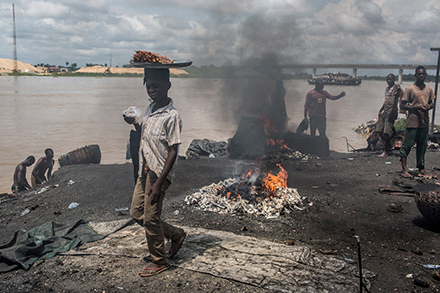
Nearly 98% of children under the age of five years old in low- and middle-income countries (LMIC) live in areas where fine particulate matter levels exceed the guidelines recommended by the World Health Organization. Studies in high income settings have shown air pollution poses a danger to healthy neurodevelopment, but similar research in LMIC is lacking. NIEHS has continued to pursue collaborative opportunities with domestic and international organizations to focus attention on this issue.
A recent research project funded by NIEHS and the Fogarty International Center (Fogarty), Air Pollution Exposures in Early Life and Brain Development in Children , headed by Sarah Benki-Nugent, Ph.D., University of Washington, builds on the foundation laid by Fogarty through the Global Brain and Nervous System Disorders Research across the Lifespan (Global Brain) series of grants that began in the early 2000s. These initiatives aim to address a research gap in sub-Saharan Africa and build capacity for work in the area of nervous system function and impairment, reflecting the culmination of many years of cultivating partnerships with institutions in LMIC.
Benki-Nugent will expand upon her work initiated with the Kenya Healthy Home Healthy Brain Project to examine early life exposure to air pollution and child neurodevelopmental outcomes. Her project will establish a pre-conception cohort for the prospective study and use mobile monitoring devices as well as neurotoxic biomarkers to capture air pollution exposures.
Global BRAIN Program
Though the burden of disorders of and affecting the nervous system constitutes a large proportion of non-communicable disease globally, the impact in LMICs has not been adequately addressed. In response, Fogarty established the Global BRAIN program in 2002 with the goal of supporting research, building research capacity, encouraging innovation in diagnostics, prevention, and treatment, promoting collaboration among LMIC institutions, and fostering early career investigators in those institutions. As of 2018, the program has awarded 165 R21s and 61 R01s across 41 LMICs.
The new project leverages existing resources in sub-Saharan Africa, capitalizing on the long-standing partnership between the University of Washington and the University of Nairobi in maternal and child health research. This 30-plus year collaboration has created a strong network of academic and governmental partners in Kenya engaged in increasing research capacity and pursuing innovative methods to investigate child neurodevelopment.
This is the first grant funded by NIEHS to explore early exposure to ambient air pollution and brain development in Africa. This research adds to other NIEHS-funded studies examining air pollution and neurodevelopment in children that are occurring in high-income countries. Patrick Ryan, Ph.D., Cincinnati Children's Hospital Medical Center, and his group conducted a study on traffic-related air pollution (TRAP) in the Cincinnati Childhood Allergy and Air Pollution Study cohort and discovered structural changes in children's brains related to their exposure to TRAP. Using a systems approach , Devon Payne-Sturges, Dr.P.H., University of Maryland, College Park, is evaluating cumulative air pollution and additional psychosocial stressors on children's cognitive outcome. Kristina Whitworth, Ph.D., Baylor College of Medicine, is leading a study using birth cohorts in Spain to identify critical windows of susceptibility of environmental air pollution on child neurodevelopment. Benki-Nugent's work will provide important data on this research area in a low-resource and high exposure setting.

